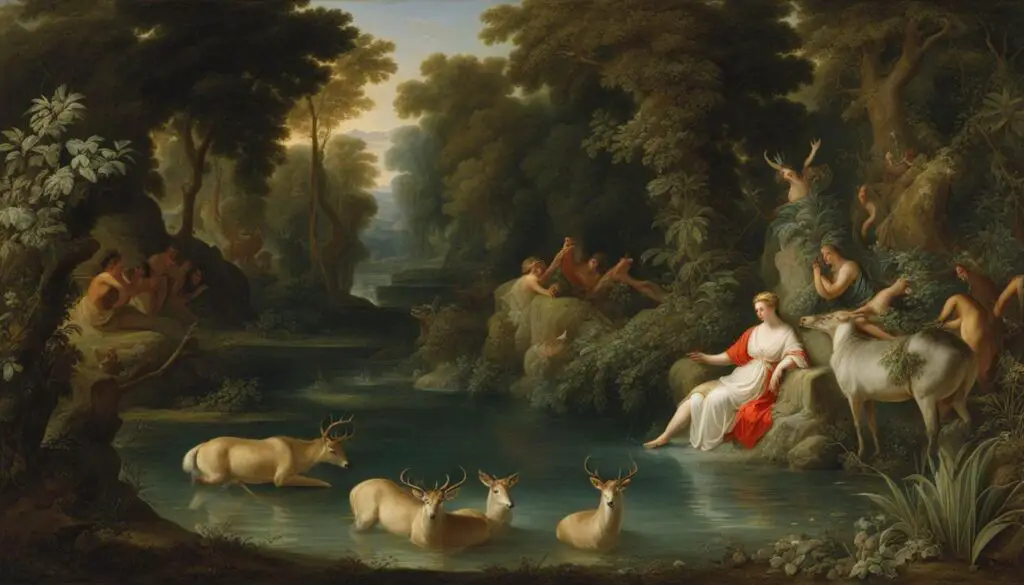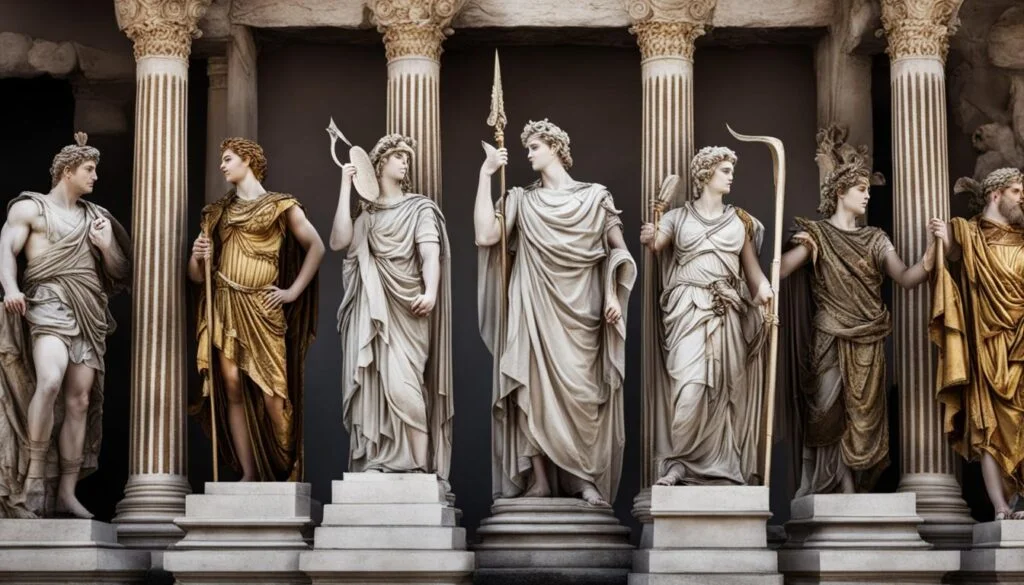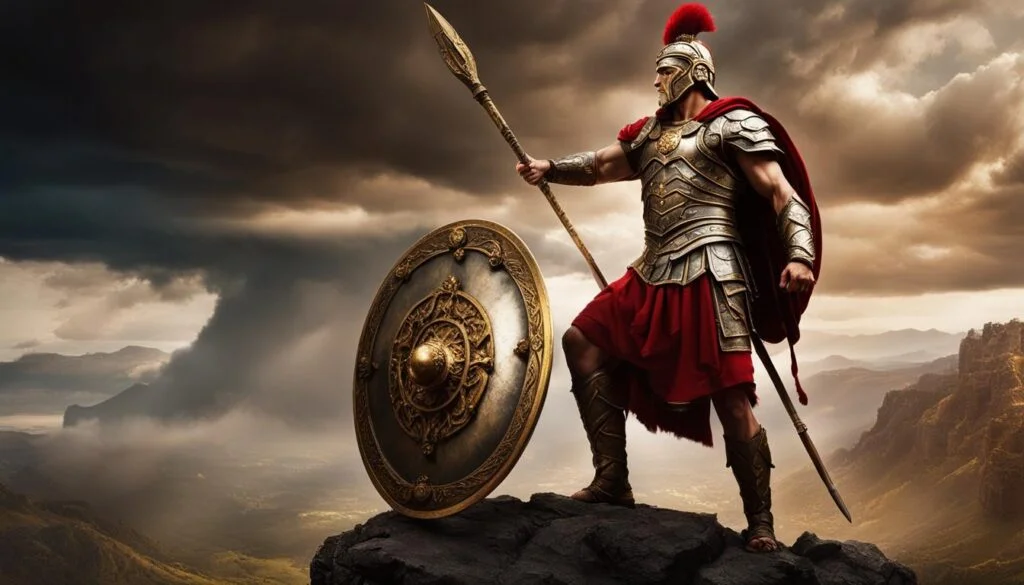The myth of Diana and Actaeon is a fascinating story rooted in ancient Greek mythology.
It revolves around the encounter between Actaeon, a young hunter, and Diana, the goddess of hunting.
This captivating tale explores themes of punishment, boundaries, and the capricious nature of the gods.
In this mythological tale, Actaeon accidentally stumbles upon Diana and her attendant nymphs while they are bathing in a forest pool.
Diana, angered by Actaeon’s intrusion, transforms him into a stag. Unable to recognize their former master, Actaeon is hunted down and killed by his hounds.
The myth of Diana and Actaeon serves as a cautionary tale about the consequences of disrespecting the divine and violating sacred spaces.
It emphasizes the importance of respect, modesty, and the need to honor the boundaries set by the gods.
Key Takeaways:
- The myth of Diana and Actaeon explores themes of punishment, boundaries, and power dynamics in ancient Greek mythology.
- Actaeon’s transformation into a stag symbolizes the consequences of defying the gods and trespassing on sacred spaces.
- The hunt and death of Actaeon highlight the concept of retribution in Greek mythology.
- The myth serves as a reminder of the moral complexities and ethical implications present in ancient stories.
- The story continues to have an enduring legacy in modern culture, inspiring various artistic interpretations and works of literature.
The Characters in the Myth of Diana and Actaeon
The myth of Diana and Actaeon features several key characters who play crucial roles in the story.
The main characters are Actaeon, a young hunter raised by the wise centaur Chiron, and Diana, the goddess of hunting.
Actaeon’s chance encounter with Diana and her attendant nymphs while they are bathing sets the events of the myth in motion.
Actaeon, known for his skill in hunting, inadvertently stumbles upon Diana’s secret bathing spot.
This accidental intrusion brings forth the wrath of the goddess, leading to Actaeon’s unfortunate fate.
Diana, also known as Artemis, is a powerful deity associated with the hunt, the moon, and chastity.
As the story goes, Diana is outraged by Actaeon’s audacity and invokes her divine power to transform him into a stag.
This transformation serves as a form of punishment for Actaeon’s transgression.
The Centaur Chiron and the Attendant Nymphs
In addition to Actaeon and Diana, other important characters in the myth include Chiron, the centaur who raised Actaeon.
Chiron, renowned for his wisdom and knowledge, plays a significant role in Actaeon’s upbringing and serves as a mentor figure for the young hunter.
The nymphs, who accompany Diana during her bath, are also noteworthy characters in the myth.
These ethereal beings are associated with nature and are often depicted as beautiful maidens.
In the story of Diana and Actaeon, the nymphs bear witness to Actaeon’s unfortunate encounter with Diana and play a part in the unfolding events.
Intriguing Interactions Among Gods and Mortals
The myth of Diana and Actaeon exemplifies the complex interactions between gods and mortals in Greek mythology.
It showcases the consequences of mortals trespassing into the divine realm and the swift retribution that follows.
As Actaeon and Diana’s stories intertwine, the myth delves into themes of power, boundaries, and the capricious nature of the gods.
The characters in this ancient tale continue to captivate audiences, offering insights into the moral complexities and timeless lessons embedded within Greek mythology.
The Transformation of Actaeon
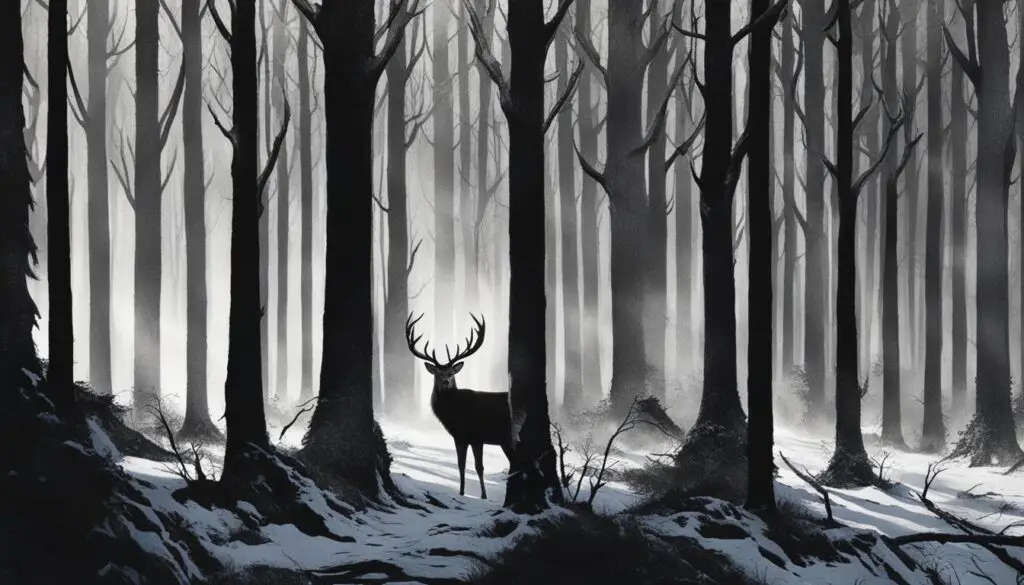
In the myth of Diana and Actaeon, the young hunter Actaeon suffers a severe punishment for daring to gaze upon the naked goddess Diana.
In her wrath, Diana transforms Actaeon into a stag, stripping him of his human form and leaving him vulnerable and defenseless.
This dramatic metamorphosis serves as a powerful symbol of the consequences that befall those who disrespect the divine.
Actaeon’s transformation into a stag highlights the swift and drastic punishment inflicted by Diana for his trespassing.
It also serves as a cautionary tale, warning mortals against encroaching upon sacred spaces or violating the boundaries set by the gods.
The Hunt and Death of Actaeon
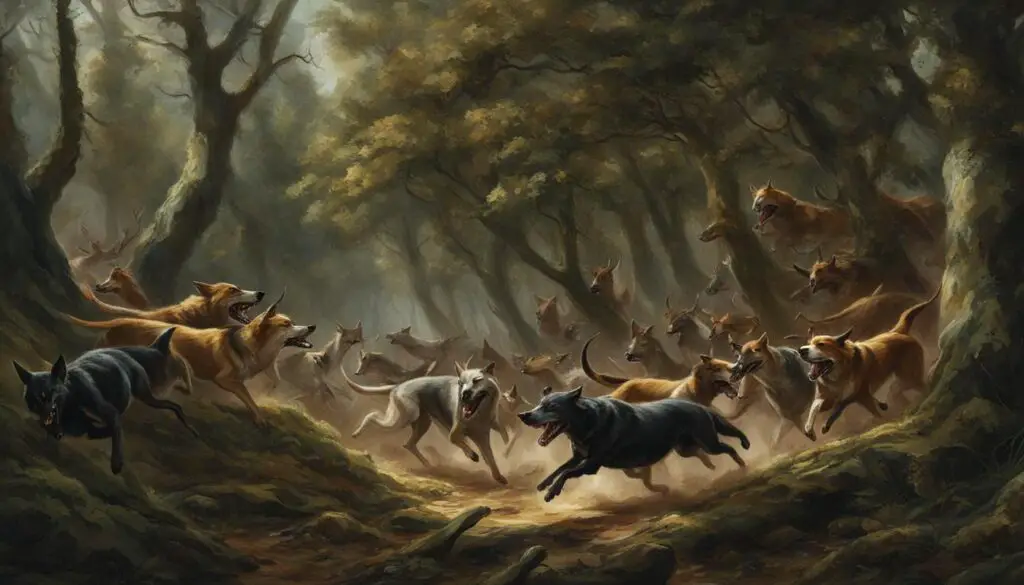
Once Actaeon is transformed into a stag, his fate takes a dark turn.
He becomes the hunted, pursued by his hounds who no longer recognize him.
These once loyal companions, now driven by instinct, relentlessly chase Actaeon through the forest.
The hunt is filled with tension and danger as Actaeon desperately tries to escape his impending doom.
The hounds, fueled by their primal instincts, close in on him, their barks echoing through the trees. Actaeon, now stripped of his humanity, must face the harsh reality of Diana’s punishment.
Actaeon’s death is a brutal reminder of the severity of Diana’s retribution.
His hounds tear him apart, oblivious to the fact that they are killing their former master.
The scene is a stark depiction of the consequences that await those who dare to trespass upon the domain of the gods.
In Greek mythology, retribution is a recurring theme, and Actaeon’s death serves as a cautionary tale.
It highlights the importance of respecting the boundaries set by the divine and the dire consequences that befall those who disregard them.
The hunt and Actaeon’s demise demonstrate the unforgiving nature of the gods and the unyielding justice they mete out.
Symbolism and Themes in the Myth of Diana and Actaeon
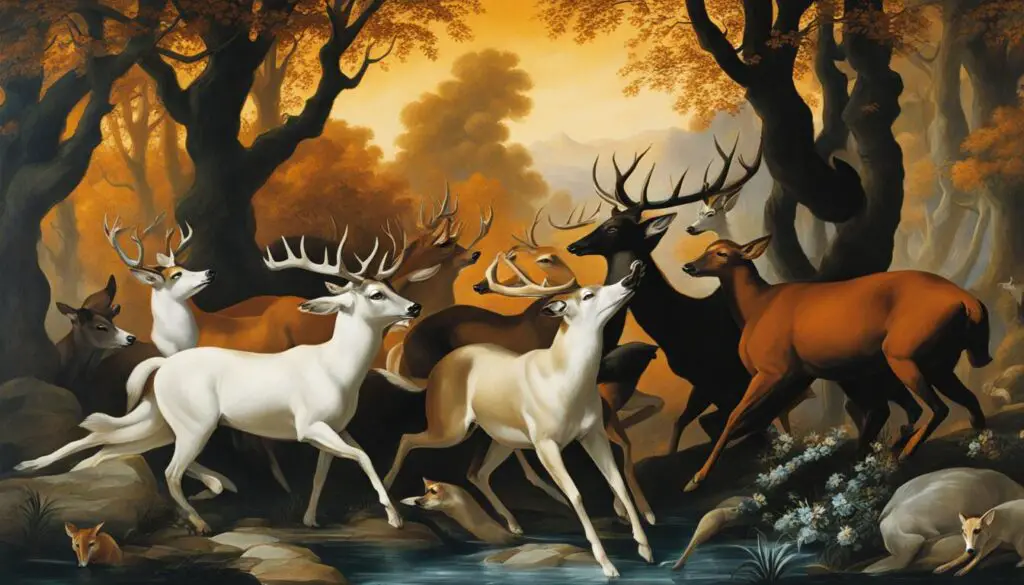
The myth of Diana and Actaeon delves into numerous themes and symbolism, providing insights into the consequences of violating divine boundaries.
It serves as a cautionary tale, highlighting the importance of respect and modesty. The transformation of Actaeon into a stag and his subsequent death symbolize the swift and harsh punishment that defying the gods can bring.
This story also explores the power dynamics between mortals and deities, shedding light on the capricious nature of the gods.
The symbolism in the myth of Diana and Actaeon extends beyond the physical transformation of Actaeon. His transformation represents the loss of his humanity and the vulnerability that comes with defying the divine.
It serves as a warning against trespassing on sacred spaces and violating the boundaries set by the gods.
The consequences Actaeon faces illustrate the importance of respecting the power and authority of the gods.
The themes in Greek mythology that are present in this myth include punishment, respect for the divine, and the consequences of audacity.
It serves as a reminder that mortals must navigate carefully within the realm of the gods, as transgressions can lead to severe retribution.
Furthermore, the myth of Diana and Actaeon has inspired various authors and artists throughout history.
Its themes and symbols have become recurring motifs in literature and art, highlighting the enduring appeal and relevance of ancient myths in modern culture.
- Violating divine boundaries and the consequences that follow
- The power dynamics between mortals and deities
- The capricious nature of the gods
- The loss of humanity and vulnerability in defying the divine
- The importance of respect and modesty
- The punishment and retribution for audacity
Artwork and literature that draw inspiration from the myth of Diana and Actaeon further explore these themes and symbols, demonstrating the enduring impact and significance of mythical tales in literature and art.
Depictions of the Diana and Actaeon Myth in Art
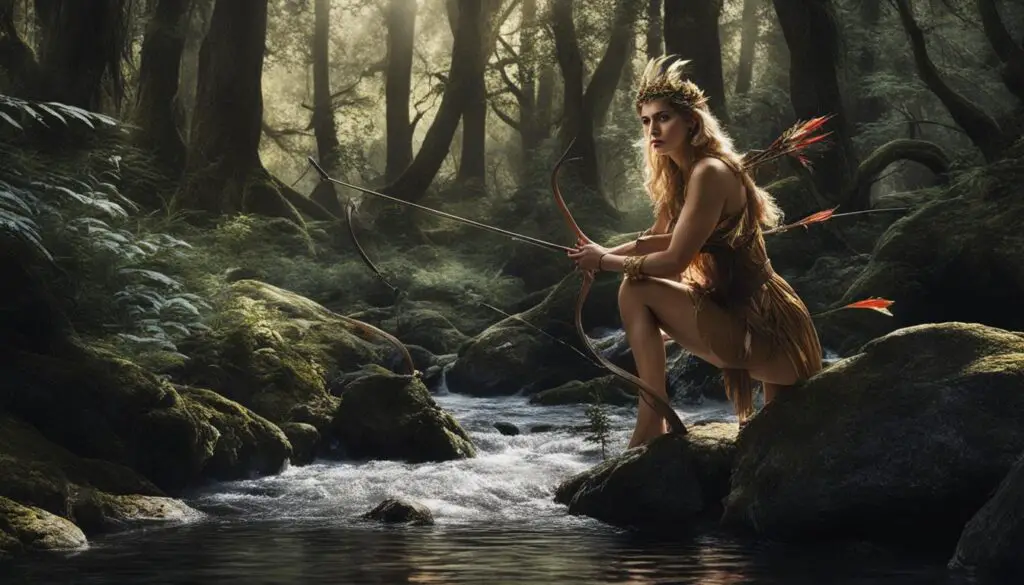
The myth of Diana and Actaeon has long served as a source of inspiration for artists throughout history.
One remarkable artistic interpretation of this captivating story is Titian’s painting, “Diana and Actaeon.” This masterpiece captures the pivotal moment when Actaeon unexpectedly encounters Diana while she is bathing.
The painting is part of a larger series that includes “The Death of Actaeon,” further exploring the dramatic tension and visual allure of the myth.
Titian’s “Diana and Actaeon” exemplifies the beauty and skill of Renaissance art. The intricate details, vibrant colors, and masterful composition draw viewers into the mythological scene, effectively conveying the surprise and tension of the encounter.
This artwork not only showcases the artistic prowess of Titian but also highlights the enduring impact of the Diana and Actaeon myths on Renaissance art.
Aside from paintings, the myth of Diana and Actaeon has found expression in other forms of art as well.
Ballet performances have choreographed stunning adaptations of the story, while filmmakers have been inspired to bring this myth to life on the silver screen.
These artistic reinterpretations allow audiences to engage with the timeless themes and captivating narrative of the myth in a variety of mediums.
The Influence of the Diana and Actaeon Myth in Literature
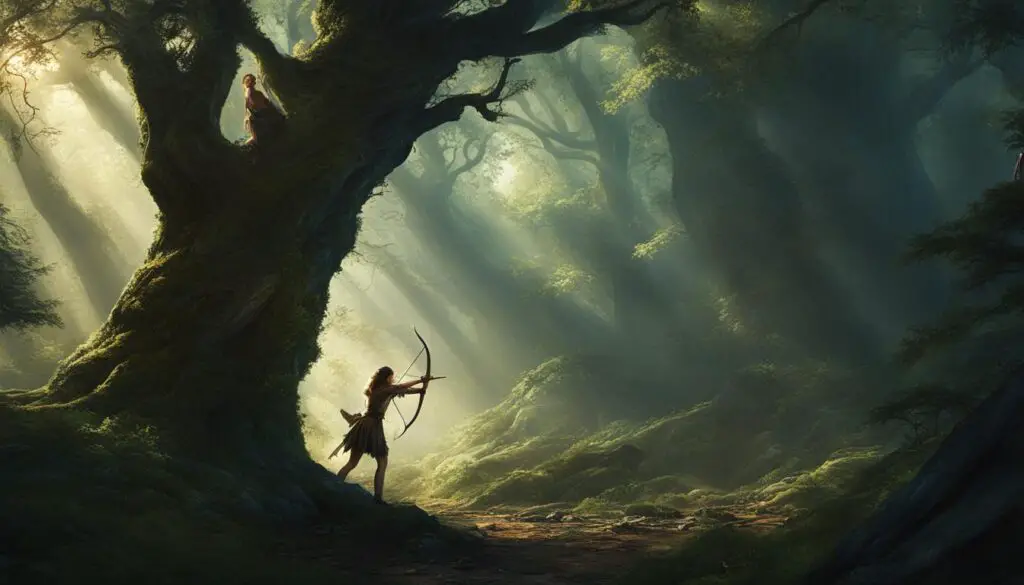
The myth of Diana and Actaeon has had a significant impact on works of literature throughout history.
Poets such as T.S. Eliot and E.E. Cummings have drawn inspiration from this timeless myth, using it as a vehicle to explore themes of chastity, audacity, and the power dynamics between men and women.
Through their poems, these renowned poets delve into the complexities of the myth, weaving together powerful images and thought-provoking narratives.
They bring to life the dramatic tension and emotional depth found in the story of Diana and Actaeon, captivating readers with their modern interpretations of this ancient myth.
The myth of Diana and Actaeon resonates with poets and readers alike because of its enduring themes, which continue to hold relevance in contemporary society.
The power struggles, moral dilemmas, and the consequences of transgressing boundaries explored in this myth are universal and timeless.
Furthermore, the emotional intensity and narrative richness of the myth make it fertile ground for poetic exploration.
Poets can tap into the mythological themes of transformation, punishment, and divine intervention, infusing their creative voice and vision into the ancient narrative.
Modern Interpretations of Ancient Myths
Beyond the works of Eliot and Cummings, many other poets and authors have reimagined and reinterpreted the myth of Diana and Actaeon in their literary creations.
These modern interpretations breathe new life into the ancient story, capturing the imagination of readers and showcasing the enduring power of myths.
Some poets explore the psychological depths of the myth, delving into the inner turmoil and conflicts faced by the characters.
Others emphasize the myth’s symbolic dimensions, using it as a metaphor to explore broader themes of desire, power, and identity.
These contemporary interpretations highlight the ongoing importance and relevance of ancient myths in literature.
By engaging with these timeless narratives, poets and authors connect with the universal human experiences and emotions that these myths encapsulate, creating a bridge between the past and the present.
The Significance of the Diana and Actaeon Myth in Modern Culture
The myth of Diana and Actaeon holds a significant place in modern culture, as it has been referenced in various forms of media, including literature, film, and television.
This ancient Greek myth continues to captivate audiences and remains relevant due to its enduring themes of punishment, boundaries, and power dynamics.
These themes resonate with viewers and provide rich material for exploration and reinterpretation in contemporary storytelling.
In literature, authors draw inspiration from the myth of Diana and Actaeon to explore themes of morality, consequences, and the complexities of human desires.
The story serves as a foundation for examining the balance of power between mortals and deities, highlighting the capricious nature of the gods and the catastrophic outcomes that can befall those who dare to transgress divine boundaries.
In the film industry, the myth of Diana and Actaeon offers filmmakers a powerful narrative that can be adapted and reimagined in various ways.
Directors often incorporate elements of the myth to explore themes of transformation, identity, and the repercussions of forbidden curiosity.
The story’s dramatic tension and timeless themes continue to provide filmmakers with opportunities to craft visually stunning and thought-provoking cinematic experiences.
The myth’s enduring presence in popular culture speaks to the timeless nature of ancient stories.
It serves as a reminder of the profound impact that mythological tales can have on human imagination and the universal themes they address.
The myth of Diana and Actaeon continues to inspire and fascinate new generations, demonstrating the longevity and relevance of ancient Greek mythology.
Comparisons to Other Myths and Stories
The myth of Diana and Actaeon shares similarities with other tales from Greek mythology.
These stories explore themes of punishment and transformation, highlighting the consequences of defying divine boundaries or societal norms.
Let’s take a closer look at two other myths that bear resemblance to the story of Diana and Actaeon:
The Myth of Narcissus and Echo
In the myth of Narcissus and Echo, Narcissus falls in love with his reflection in a pool of water.
Similarly, Actaeon’s punishment stems from his encounter with the bathing Diana.
Both myths demonstrate the dangers of arrogance and vanity, emphasizing the need for humility and self-awareness.
The Story of Lady Godiva
In the story of Lady Godiva, a noblewoman rides through the streets naked, covered only by her long hair, to protest her husband’s high taxes.
This act challenges societal norms and boundaries, much like Actaeon stumbling upon the bathing Diana.
Both tales explore the courage to defy expectations and the potential risks involved.
These myths, including the tale of Diana and Actaeon, reveal the enduring themes and lessons present in Greek mythological tales.
They serve as cautionary tales, reminding us of the importance of respecting divine boundaries, societal norms, and the consequences that may arise from challenging them.
- The Myth of Narcissus and Echo
- The story of Lady Godiva
Lessons and Morals from the Myth of Diana and Actaeon
The myth of Diana and Actaeon from Greek mythology holds valuable moral lessons and teachings.
It conveys the significance of respecting boundaries and the dire consequences that follow when those boundaries are violated.
The story also serves as a reminder of the erratic nature of the gods and emphasizes the need for reverence and humility in the presence of the divine.
The myth of Diana and Actaeon highlights the moral complexities and ethical implications present in ancient mythological tales.
It prompts us to reflect on the importance of ethical behavior and the consequences of disregarding moral principles.
By exploring the moral teachings in ancient stories like this, we gain insights into human nature, the consequences of our actions, and the timeless wisdom encapsulated in these mythological tales.
Continuing Legacy of the Diana and Actaeon Myth
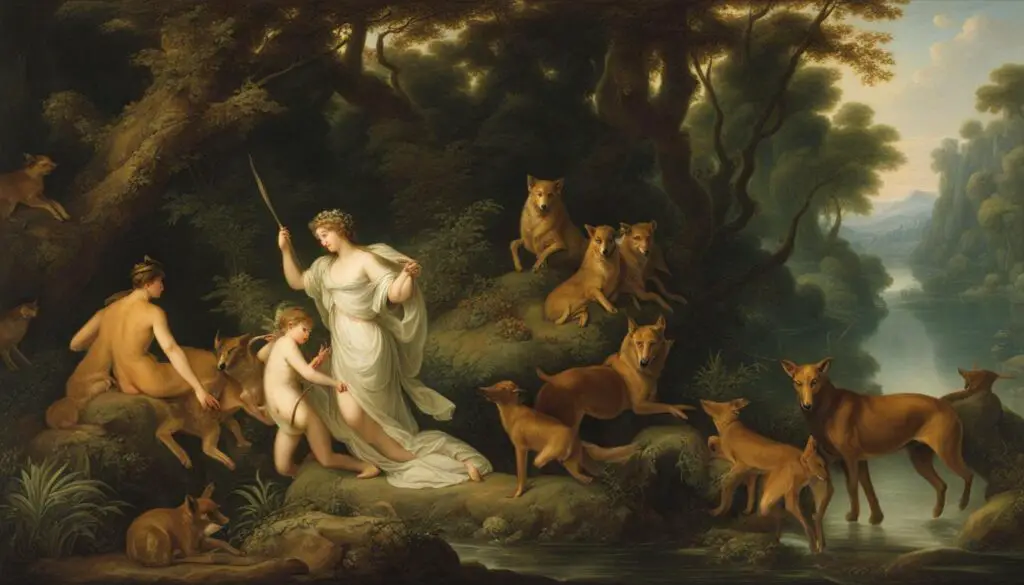
The myth of Diana and Actaeon, a captivating tale from Greek mythology, has left a lasting impact on audiences and continues to be a popular story.
Its timeless themes of punishment, boundaries, and power dynamics have been explored and interpreted in various forms of art and literature.
The enduring popularity of the myth speaks to the lasting relevance of ancient stories in modern times.
Despite being rooted in a different era, the myth of Diana and Actaeon resonates with audiences today, highlighting the enduring power of these ancient tales to captivate and inspire.
Whether it is depicted in paintings, ballets, or films, the legacy of the Diana and Actaeon myth lives on and provides a rich source of inspiration for artists and writers.
The allegorical nature of the story, which touches on universal themes of morality and respect, allows for different interpretations and ensures its continued relevance for generations to come.
Conclusion
The myth of Diana and Actaeon is a captivating tale from Greek mythology that explores profound themes of punishment, boundaries, and power dynamics.
It serves as a cautionary tale about the dire consequences of defying the gods and emphasizes the fundamental importance of respect and modesty in our interactions with the divine.
Throughout history, the myth of Diana and Actaeon has inspired countless works of art, literature, and other forms of creative expression.
Its timeless themes and moral teachings continue to resonate with audiences, making it an enduring story that evolves in its interpretations while retaining its fundamental essence.
With its rich symbolism and dramatic narrative, the myth of Diana and Actaeon offers profound insights into the capricious nature of the gods and the complexities of mortal existence.
It is a reminder that the boundaries set by the divine are not to be transgressed lightly, as there are consequences to be faced when one disregards the will of the gods.
The enduring legacy of the myth of Diana and Actaeon speaks to the enduring power and relevance of ancient stories in modern culture.
As we engage with these timeless narratives, we are reminded of the moral complexities, ethical implications, and the enduring human fascination with the gods that permeate our collective consciousness.
Frequently Asked Questions
Q: What is the mythological story of Diana and Actaeon?
In Greek mythology, Actaeon, a young hunter, accidentally stumbled upon Diana (known as Artemis in Greek), the goddess of the hunt, while she was bathing. Outraged at being seen naked, Diana transformed Actaeon into a stag, and he was subsequently torn apart by his own hunting dogs.
Q: What is the moral of the story Diana and Actaeon?
The moral of the story revolves around themes of respect, privacy, and the consequences of unintentional transgression. It warns against the dangers of intruding upon the divine or violating sacred boundaries.
Q: Why was Actaeon punished by Diana?
Actaeon was punished by Diana because he saw her naked while she was bathing, which was considered a severe violation of her chastity and privacy. As a virgin goddess, Diana held her purity in high regard, thus reacting harshly to preserve her dignity.
Q: What is the symbolism in Diana and Actaeon?
The story of Diana and Actaeon is rich in symbolism, highlighting themes of human vulnerability, the untouchable nature of the divine, and the swift and often harsh justice meted out by gods. Actaeon’s transformation into a stag symbolizes his complete loss of humanity and the consequences of divine retribution.
Q: What does Diana throw at Actaeon when he sees her?
In the myth, Diana splashes water on Actaeon and curses him, which leads to his transformation into a stag. Some versions specify that she throws water mixed with magical elements at him as part of the transformation curse.
Q: What is Diana’s mythological importance?
Diana is a Roman goddess of the hunt, moon, and birthing, associated with wild animals and woodland. She is known for her strength, independence, and protective nature over women and children. Her Greek counterpart is Artemis.
Q: What was the guilt of Actaeon?
Actaeon’s guilt lies in his accidental witnessing of Diana’s nakedness. Although his intrusion was unintentional, he paid the ultimate price for seeing the goddess without her consent, illustrating the severe penalties for even unintended sacrilege in mythological stories.


